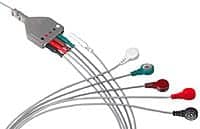 |
For decades, many careers and fortunes have risen and fallen in pursuit of a Holy Grail: Real-time plug-and-play medical device interoperability at the point of care and throughout the enterprise. Untold millions of dollars have been poured into one effort after another, or one technology or demonstration project after another, only to fizzle out when the resources dried up or the activity hit a wall—typically due either to vendor resistance or to care provider apathy. Yet another year has passed, and though there has been measurable progress, it is clear that all the needed pieces have yet to fall into place, begging the question: Are we truly any closer to the tipping point?
In a recent Boston Globe article,1 the need for highly integrated, seamless device connectivity, along with the potential improvements in patient safety, quality of care, and clinical workflow efficiency, was recognized. It too lamented the lack of progress toward this end, especially in this increasingly digital age, and suggested that perhaps the industry tipping point would result from a revolutionary killer application, much like the iPod in consumer electronics. Perhaps, but many fail to appreciate some of the fundamental difficulties and differences between medical device systems and those in other industries.
Today, this dichotomy can often be seen in technology disconnects, such as those between providers of general purpose health IT infrastructure equipment and providers of medical device networking systems in which one says, “We’ve already solved this problem—what’s the big deal here?!” and the other says, “You really don’t understand medical systems!!!”
 |
| Connectivity success requires consistent semantics from the sensor to the EHR, regardless of the device source. |
WHY IS IT SO HARD?
Why is highly integrated medical device infrastructure so difficult?
- Failure is not an option. Though our consumer electronics provide an amazing level of functionality and integration, even compared to only 1 or 2 years ago, people are typically not sent to emergency departments when the consumer product fails to work as advertised. The challenge of providing increased functionality and integration, while at the same time reducing risks to patient safety, are orders of magnitude more difficult for medical device systems.
- Regulatory approval is non-negotiable. Currently, there is no accepted model for evaluating and ensuring the safety and reliability of these next generation highly integrated, dynamically configured plug-and-play medical device systems. Evolving the international regulatory model to address these next generation systems is a formidable barrier, and it faces as many political and legal obstacles as it does scientific.
- Device external control is a must. Looking at many of the clinical use cases being investigated by Julian M. Goldman, MD’s medical device “Plug-and-Play” (MD PnP) group, and captured by its integrated clinical environment (ICE) standardization work, a common aspect is the need for device external control in a heterogeneous (multivendor, multidevice modality) plug-and-play environment. Few medical devices provide external control mechanisms today. Controls based on open standards technologies currently are only in prototype stages at best. This will not happen overnight!
- Semantics … semantics … semantics. In reality, the networking and application services model for device connectivity is the simple part of the problem. The hard part is the abstract semantics (and associated formalisms) that enable truly unambiguous communication. This concept often is neither well understood nor properly factored into integrated system design, but attaining the Grail requires consistent semantics from the sensor to the EHR, regardless of the device source. A point-of-care example would be a PCA pump that is providing patient-triggered drug administration, but wants to receive regular updates of the patient’s heart rate, respiration rate, or SpO2 to prevent overmedication. To accomplish this, though, the pump would have to issue a general query—using standardized semantics that all the other networked devices would understand—to see which other devices might be able to provide the requested parameters at the required intervals with the desired resolution and unit of measurement.
- Business models must evolve. Today, medical device technology vendors spend millions and millions of dollars getting a single device to the marketplace, or even getting a new revision of existing equipment upgraded in the field. This investment includes product design, extensive testing, regulatory approval, field trials, service support, training, etc. Deploying health technology into a nascent market (eg, the current push for personal health devices) or a consumer market in which millions of systems are sold annually is a much easier proposition than effecting a sea change in a very mature market where companies have billion-dollar investments and where the volumes are orders of magnitude smaller. These and other significant barriers have held back the needed innovation in integrated medical device systems: However, the good news is that that is not the end of the story.
MOVING FORWARD
Is there any hope that these barriers will be addressed anytime soon?
- The American Health Information Community’s (AHIC) CDC Use Case: The AHIC published a Common Device Connectivity use case at the end of 2008 that could greatly accelerate the addition of standards-based medical device connectivity to the emerging nationwide health information network (NHIN). The use case includes not only the “first connection” on the device itself but also the semantics that are exchanged and used to drive point of care and enterprise-level clinical applications, including EHR and decision support systems. This will affect all US government purchasing decisions for medical devices and associated informatics technologies.
- HDOs Unite: A collaborative of the HealthCare Delivery Organizations’ (HDOs) recently issued standard contract wording intended to be included for all purchases of medical device systems that require support for standards-based connectivity. This Medical Device FIRE RFP and contracting template is open and intended to evolve with more experience and increased adoption. If it catches on, it could have a significant effect on the overall industry business model and address the apathy problem mentioned above.
- Vendor Cooperation. Numerous major vendors have been working side by side within the Integrating the Healthcare Enterprise (IHE) patient care device (PCD) group for more than 4 years now developing a standards-based technology framework that addresses clinical device integration problems such as alarm communication management, streaming data to clinical information systems, infusion parameter verification, medical equipment management, etc.
- Rosetta Semantics: The IHE PCD has also spearheaded a drive to map vendor-specific semantics to a harmonized set of standard terms that also captures coconstraints among parameters, their units of measurement, enumerated values, and associated body sites. This is directly addressing the need for consistent semantics across all device modalities, from personal health to the operating room and intensive care unit.
- Standards Coordination: There is ever-increasing collaborative work among the various standards organizations that are working to fill the remaining device connectivity technology gaps. This includes the “ICE-PAC” joint working group between the ICE standard development team and the IHE PCD group, which is performing a map/gap analysis of ICE use cases to see what standards components exist and which need to be extended or created. These include standards from ISO, IEEE, HL7, and ASTM.
- Risk Management and IEC 80001-1: An international risk management standard is being created to address IT networks that include medical devices (see the July 2008 column in 24×7). This standard will provide the basis for managing many of the issues associated with integrating technology from different vendors so as to ensure patient safety and proper operation.
- US Economic Stimulus Package: The constant buzz around any health-related group these days is the anticipated windfall of dollars from Washington as the new administration includes health care technology as part of its economic incentive package. Though many have been waiting for that “killer application” to launch the next wave of medical device system evolution, a modest injection of resources to address many of the barriers above might just do the trick.
So are we finally nearing the tipping point, or are those few dedicated fanatics simply continuing in a Sisyphean pursuit of the Grail? Having followed this area for more years than I’d like to remember, there is a rational basis for hope and that iPod-esque killer application may truly be right around the corner. On the downside, there is history and that pesky international financial crisis … it’s always something!
Todd Cooper is president of Breakthrough Solutions Foundry Inc, which serves the medical device informatics and interoperability arena; and is engaged in a number of device informatics standards groups within ISO, IEEE, HL7, and IHE. For more information, contact .
REFERENCE
- Johnson CY. Medical devices lag in iPod age. The Boston Globe. December 29, 2008:A9. Explore More
To learn more about the organizations discussed in the article and their projects, explore the following Web sites:
- The medical device “Plug-and Play” (MD PnP) group: www.mdpnp.org;
- The MD PnP group’s integrated clinical environment (ICE) standardization work: www.mdpnp.org/ICE.html;
- The American Health Information Community, or AHIC, (www.hhs.gov/healthit/community/background/) was recently reorganized as the National eHealth Collaborative: www.nationalehealth.org;
- For more on the common device connectivity use case: www.hhs.gov/healthit/usecases/comdev.html;
- For the emerging nationwide health information network, or NHIN: www.hhs.gov/healthit/healthnetwork/background/;
- For more on the HealthCare Delivery Organizations’ Medical Device FIRE document: mdpnp.org/MD_FIRE.php;
- To read about Integrating the Healthcare Enterprise (IHE) patient care device (PCD) group: www.ihe.net/pcd; and
- For more on Rosetta terminology: www.ihe.net/Technical_Framework/upload/IHE_PCD_TF_Supplement_Rosetta_Terminology_Mapping_RTM_TI_2008-08-22.pdf.





